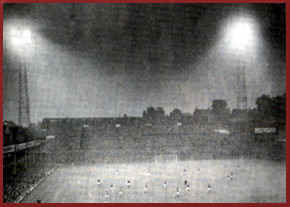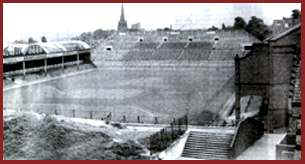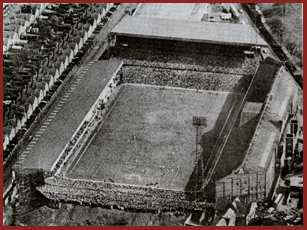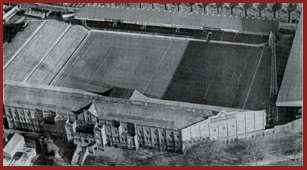Aston
Villa made the historic move to Villa Park in 1897 - quite
fittingly, only seven days after the League and Cup double had
been achieved. Moving out of their old Perry Barr ground at Wellington Road was
the crowning moment to a marvellous season. Although it was sad
to leave this famous old venue and bring an era to a close, at
the same time Villa looked forward to even greater days ahead in
their new home. The ground was officially opened on Easter
Saturday, April 17, with a First Division game against Blackburn
Rovers, although then it was still known as Aston Lower Grounds.
It was not called Villa Park until the following year.
Moving out of their old Perry Barr ground at Wellington Road was
the crowning moment to a marvellous season. Although it was sad
to leave this famous old venue and bring an era to a close, at
the same time Villa looked forward to even greater days ahead in
their new home. The ground was officially opened on Easter
Saturday, April 17, with a First Division game against Blackburn
Rovers, although then it was still known as Aston Lower Grounds.
It was not called Villa Park until the following year.
On a wet and blustery afternoon, Villa won the game 3-0 in
front of over 15,000 spectators, with Johnny Campbell making
history by scoring the first goal on the new ground. Villa Park
at this time, though, still belonged to Flowers & Co, a
brewery from Stratford-upon-Avon.
It was Frederick Rinder and Charles Johnstone who did the
early work in negotiating a lease from the owners and it ran for
a 21 year period at a starting rent of £250 per annum. Rinder,
quite wisely, negotiated an added option to purchase the land at
five shillings a square yard within 21 years and by 1911 Villa
were well on the way to owning a stadium which would compare
with the best in the world. For a number of years, however, the
new ground remained incomplete as there was very little covered
accommodation.
It had a stand which seated 5,500 fans, with another 4,500
standing in front, and on the Trinity Road side of the stadium
approximately 8,000 could find accommodation. But the rest of
the Villa fans had to be content with open-terracing - and on
matchdays were often drenched. Gradually though, with Frederick
Rinder's guidance, the ground was completely overhauled and
original features from the ground's amusement park days, such as
the aquarium, the restaurant, the roller skating rink and the
cycling track, were either dismantled or adapted for another
purpose.
A solid roof was erected over the Witton Lane side of the
ground and Villa installed new offices and a gymnasium within
the building.
An impressive practice pitch was laid at the rear of the
ground and Villa also made room for a sizeable car park on the
site of an old theatre. Much of the credit for the actual design
of Villa Park must to go Rinder, who had visualised its eventual
appearance from a number of sketches he had made himself and
passed on to a well-established architect of the day, E B
Holmes.
Rinder's structural ideas originally called for a ground that
would hold 130,000 people and, but for the outbreak of World War
One, the Villa chairman's ambition would no doubt have been
realised, with the creation of the finest stadium in Great
Britain. With his plans put on hold during the war, work on
Rinder's vision continued in 1918, although his ambitious
pre-war schemes were only ever partially developed. The Witton
Lane stand was extended and the banking behind both goals was
built up, but it was not until 1922 that he modern Trinity Road
stand was built to replace the old covered enclosure.
Opened by King George VI in 1924 and open to the public a
year earlier, this stand still remains a prominent feature of
Villa Park today. Other than the improvement of crash barriers
and perimeter walls, and the installation of new turnstiles, the
only other major redevelopment up to 1940 was done on the Holte
End terracing which, despite severe restrictions on building,
was made even higher during the early years of the war. Villa
Park was finally complete but it had been built to house only
80,000 people, two-thirds the number Frederick Rinder had
originally intended.
After the Second World War was declared, Villa Park was
closed for football and given over to the military, with the
Trinity Road stand converted into an air-raid shelter and stores
and the dressing rooms being used by a rifle company of the 9th
Royal Warwickshire Regiment.
The ground came under fire from German bombers in the early
war years and during one raid, part of the roof of the Witton
Lane stand was actually blown off.
 Soon
after the war ended, the fans flocked back to the ground and in
March 1946 the biggest attendance ever recorded at Villa Park -
76,588 - packed inside to see Villa lose narrowly to Derby
County in the sixth round of the FA Cup. For the next 30 years
readjustments to the ground were only relatively minor, although
floodlights were installed at the ground in 1958, the Holte End
was covered in 1962 and the Witton Lane stand had its old
'rounded-roof' removed and replaced with a more conventional
sloping one in 1964.
Soon
after the war ended, the fans flocked back to the ground and in
March 1946 the biggest attendance ever recorded at Villa Park -
76,588 - packed inside to see Villa lose narrowly to Derby
County in the sixth round of the FA Cup. For the next 30 years
readjustments to the ground were only relatively minor, although
floodlights were installed at the ground in 1958, the Holte End
was covered in 1962 and the Witton Lane stand had its old
'rounded-roof' removed and replaced with a more conventional
sloping one in 1964.
In 1966, Villa Park was nominated as one of the venues for
the World Cup and in all the ground staged three matches in the
competition; Spain v Argentina, West Germany v Spain and
Argentina v West Germany. Villa, though, had to spend £99,450
on ground improvements in order to host these games as the
players' tunnel had to be covered with a cage and more than
6,000 temporary seats were installed in the Witton Lane end.

In the late 1970s, as Villa began to re-establish themselves
back among the top clubs after a lengthy spell in the lower
divisions, plans were laid for the next major development of the
ground, with the building of the North Stand at the Witton Lane
end. The new stand was to be an impressive feature and after
completion Villa Park was completely under cover for the first
time ever. However, although the North Stand was much admired,
the manner in which it was paid for caused an enormous amount of
publicity and left the club deep in debt for a number of years.
Never before had the construction of a sporting arena caused
such a scandal as a police investigation and an internal inquiry
found that around three-quarters of a million pounds of work had
been unaccounted for. The heads of two directors rolled but this
could not prevent the club's relationships with their supports
being irretrievably damaged.
 In
1981 as Villa mounted their challenge for the championship,
electronic scoreboards were placed at the ground. Villa also
installed a mechanically powered plastic cover to try to protect
the pitch which, because of the erection of the North Stand,
lacked much needed sunlight and ventilation and suffered badly
throughout the 1980s.
In
1981 as Villa mounted their challenge for the championship,
electronic scoreboards were placed at the ground. Villa also
installed a mechanically powered plastic cover to try to protect
the pitch which, because of the erection of the North Stand,
lacked much needed sunlight and ventilation and suffered badly
throughout the 1980s.
After the Hillsborough disaster in 1989, the club were forced
to make further changes to the stadium to comply with all the
requirements of the Taylor's report into ground safety. Seats
were immediately put in place at the front of the North Stand,
but the first major stage of these alterations was finished
during the 1993/94 season. This was the impressive new Witton
Lane Stand, which is a double-decker cantilever construction
that can house 10,000 spectators and cost around £5 million to
build. The second stage started on 7 May 1994, after 45,347
supporters said an emotional farewell to Villa Park's most
notorious landmark, the Holte End. First built in the immediate
years after the First World War and named after the architect
who built Aston Hall, the Holte terrace was marginally the
largest 'kop' in English football and was viewed as the
spiritual home to the most ardent of Villa fans. With the advent
of all-seater stadiums, though, its days were numbered and
during the 1994/95 season a new Holte End had been built.
This was the final piece in the Villa Park jigsaw and, built
on a similar design to the Witton Lane and North stands, it
holds approximately 13,500 spectators, which brings the Villa
Park capacity to around 40,000.
As Aston Villa can now boast one of the finest stadiums
across Europe, a venue that would be worthy of staging any
football match.